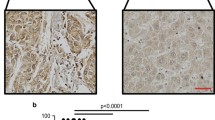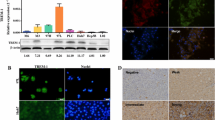Abstract
Cell death–inducing DFF45-like effector-3 (CIDE-3) is a novel member of an apoptosis-inducing protein family, but its function is unknown. CIDE-3 shows a different distribution pattern in hepatocellular carcinoma (HCC) tissues and normal adjacent tissues. Therefore, this work tested the hypothesis that CIDE-3 induces apoptosis in HCC cells, inhibiting oncogenesis and tumor development. We used immunohistochemistry to evaluate the expression of CIDE-3 in 82 HCC samples and 51 adjacent liver tissues. Overexpression of CIDE-3 induced apoptosis, as detected by flow cytometry, in the HCC cell line SMMC-7721, which had undetectable levels of CIDE-3 in the absence of CIDE-3 overexpression. A yeast two-hybrid system was employed to screen for proteins that interact with CIDE-3. The expression of CIDE-3 was decreased in HCC tissue, compared to adjacent normal tissues, and CIDE-3 expression and HCC differentiation were positively correlated. CIDE-3 expression levels were lower in poorly differentiated HCC tissue than in well-differentiated HCC tissue. Overexpressed CIDE-3 inhibited proliferation and induced apoptosis in HCC cells. We found that lipopolysaccharide-induced tumor necrosis factor (LITAF) interacted with CIDE-3 in hepatic cells. This is the first demonstrated interaction between CIDE-3 and LITAF, and the first report that CIDE-3 induces apoptosis in hepatocellular carcinoma.






Similar content being viewed by others
Abbreviations
- CIDE-3:
-
Cell death–inducing DFF45-like effector-3
- LITAF:
-
Lipopolysaccharide-induced tumor necrosis factor
- HCC:
-
Hepatocellular carcinoma
- DFF:
-
DNA fragmentation factor
- CAD:
-
Caspase-activated DNase
- PBS:
-
Phosphate-buffered saline
- DAB:
-
Diaminobenzidine
- PVDF:
-
Polyvinylidene difluoride
- TBS:
-
Tris-buffered saline
- ORF:
-
Open reading frame
- LPS:
-
Lipopolysaccharide
- NO:
-
Nitric oxide
- FISH:
-
Fluorescence in situ hybridization
References
Bruix J, Hessheimer AJ, Forner A, Boix L, Vilana R, et al. New aspects of diagnosis and therapy of hepatocellular carcinoma. Oncogene. 2006;25:3848–56.
Farazi PA, DePinho RA. Hepatocellular carcinoma pathogenesis: from genes to environment. Nat Rev Cancer. 2006;6:674–87.
Rosenstein ED, Greenwald RA, Kushner LJ, Weissmann G. Hypothesis: the humoral immune response to oral bacteria provides a stimulus for the development of rheumatoid arthritis. Inflammation. 2004;28:311–8.
Fabregat I, Roncero C, Fernandez M. Survival and apoptosis: a dysregulated balance in liver cancer. Liver Int. 2007;27:155–62.
Jacobson MD, Weil M, Raff MC. Programmed cell death in animal development. Cell. 1997;88:347–54.
Perez EA, Moreno-Aspitia A, Aubrey Thompson E, Andorfer CA. Adjuvant therapy of triple negative breast cancer. Breast Cancer Res Treat. 2010;120:285–91.
Cohen GM. Caspases: the executioners of apoptosis. Biochem J. 1997;326(Pt 1):1–16.
Wyllie AH, Kerr JF, Currie AR. Cell death: the significance of apoptosis. Int Rev Cytol. 1980;68:251–306.
Liang L, Zhao M, Xu Z, Yokoyama KK, Li T. Molecular cloning and characterization of CIDE-3, a novel member of the cell-death-inducing DNA-fragmentation-factor (DFF45)-like effector family. Biochem J. 2003;370:195–203.
Inohara N, Nunez G. Genes with homology to DFF/CIDEs found in Drosophila melanogaster. Cell Death Differ. 1999;6:823–4.
Inohara N, Koseki T, Chen S, Wu X, Nunez G. CIDE, a novel family of cell death activators with homology to the 45 kDa subunit of the DNA fragmentation factor. EMBO J. 1998;17:2526–33.
Danesch U, Hoeck W, Ringold GM. Cloning and transcriptional regulation of a novel adipocyte-specific gene, FSP27. CAAT-enhancer-binding protein (C/EBP) and C/EBP-like proteins interact with sequences required for differentiation-dependent expression. J Biol Chem. 1992;267:7185–93.
Gong J, Sun Z, Li P. CIDE proteins and metabolic disorders. Curr Opin Lipidol. 2009;20:121–6.
Stanley R, Hamilton LAA. World Health Organization classification of tumours: pathology and genetics of tumours of the digestive system. Lyon, France: IARC Press; 2000.
Yao L, Li Q, Li P, Zhang J, Ye J, et al. [Construction of the prokaryotic expression vector and expression of human CIDE-3 gene]. Xi Bao Yu Fen Zi Mian Yi Xue Za Zhi 2006; 22:202–204.
Maitra A, Wistuba II, Washington C, Virmani AK, Ashfaq R, et al. High-resolution chromosome 3p allelotyping of breast carcinomas and precursor lesions demonstrates frequent loss of heterozygosity and a discontinuous pattern of allele loss. Am J Pathol. 2001;159:119–30.
Nagao K, Yamaguchi S, Matsuyama H, Korenaga Y, Hirata H, et al. Allelic loss of 3p25 associated with alterations of 5q22.3 approximately q23.2 may affect the prognosis of conventional renal cell carcinoma. Cancer Genet Cytogenet. 2005;160:43–8.
Goto T, Phuoc NB, Nakano M, Ehara H, Yamamoto N, et al. Utility of Bcl-2, P53, Ki-67, and Caveolin-1 immunostaining in the prediction of biochemical failure after radical prostatectomy in a Japanese population. Urology. 2008;72:167–71.
Magnusson B, Gummesson A, Glad CA, Goedecke JH, Jernas M, et al. Cell death-inducing DFF45-like effector C is reduced by caloric restriction and regulates adipocyte lipid metabolism. Metabolism. 2008;57:1307–13.
Chen Z, Guo K, Toh SY, Zhou Z, Li P. Mitochondria localization and dimerization are required for CIDE-B to induce apoptosis. J Biol Chem. 2000;275:22619–22.
Puri V, Ranjit S, Konda S, Nicoloro SM, Straubhaar J, et al. Cidea is associated with lipid droplets and insulin sensitivity in humans. Proc Natl Acad Sci U S A. 2008;105:7833–8.
Wang JM, Li BC, Chen L, Wang GB, Sun H, et al. Cell death-inducing DFF45-like effector may take part in neuronal apoptosis of the lumbar spinal cord after sciatic nerve injury caused by a firearm. Mil Med. 2006;171:793–9.
Chan SC, Lin SC, Li P. Regulation of Cidea protein stability by the ubiquitin-mediated proteasomal degradation pathway. Biochem J. 2007;408:259–66.
Stiewe T. The p53 family in differentiation and tumorigenesis. Nat Rev Cancer. 2007;7:165–8.
Polyak K, Xia Y, Zweier JL, Kinzler KW, Vogelstein B. A model for p53-induced apoptosis. Nature. 1997;389:300–5.
Myokai F, Takashiba S, Lebo R, Amar S. A novel lipopolysaccharide-induced transcription factor regulating tumor necrosis factor alpha gene expression: molecular cloning, sequencing, characterization, and chromosomal assignment. Proc Natl Acad Sci U S A. 1999;96:4518–23.
Baek JY, Hur W, Wang JS, Bae SH, Yoon SK. Selective COX-2 inhibitor, NS-398, suppresses cellular proliferation in human hepatocellular carcinoma cell lines via cell cycle arrest. World J Gastroenterol. 2007;13:1175–81.
Matsumura Y, Matsumura Y, Nishigori C, Horio T, Miyachi Y. PIG7/LITAF gene mutation and overexpression of its gene product in extramammary Paget’s disease. Int J Cancer. 2004;111:218–23.
Li D, Da L, Tang H, Li T, Zhao M. CpG methylation plays a vital role in determining tissue- and cell-specific expression of the human cell-death-inducing DFF45-like effector A gene through the regulation of Sp1/Sp3 binding. Nucleic Acids Res. 2008;36:330–41.
Leist M, Gantner F, Bohlinger I, Tiegs G, Germann PG, et al. Tumor necrosis factor-induced hepatocyte apoptosis precedes liver failure in experimental murine shock models. Am J Pathol. 1995;146:1220–34.
Kakumu S, Okumura A, Ishikawa T, Yano M, Enomoto A, et al. Serum levels of IL-10, IL-15 and soluble tumour necrosis factor-alpha (TNF-alpha) receptors in type C chronic liver disease. Clin Exp Immunol. 1997;109:458–63.
Mottolese M, Nadasi EA, Botti C, Cianciulli AM, Merola R, et al. Phenotypic changes of p53, HER2, and FAS system in multiple normal tissues surrounding breast cancer. J Cell Physiol. 2005;204:106–12.
Shiraki K, Yamanaka T, Inoue H, Kawakita T, Enokimura N, et al. Expression of TNF-related apoptosis-inducing ligand in human hepatocellular carcinoma. Int J Oncol. 2005;26:1273–81.
Ishiyama K, Ohdan H, Ohira M, Mitsuta H, Arihiro K, et al. Difference in cytotoxicity against hepatocellular carcinoma between liver and periphery natural killer cells in humans. Hepatology. 2006;43:362–72.
Kremsdorf D, Soussan P, Paterlini-Brechot P, Brechot C. Hepatitis B virus-related hepatocellular carcinoma: paradigms for viral-related human carcinogenesis. Oncogene. 2006;25:3823–33.
Author information
Authors and Affiliations
Corresponding author
Additional information
Jie Min, Wei Zhang and Yu Gu contributed equally to this work.
Rights and permissions
About this article
Cite this article
Min, J., Zhang, W., Gu, Y. et al. CIDE-3 interacts with lipopolysaccharide-induced tumor necrosis factor, and overexpression increases apoptosis in hepatocellular carcinoma. Med Oncol 28 (Suppl 1), 219–227 (2011). https://doi.org/10.1007/s12032-010-9702-1
Received:
Accepted:
Published:
Issue Date:
DOI: https://doi.org/10.1007/s12032-010-9702-1




